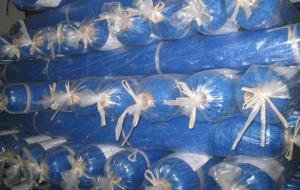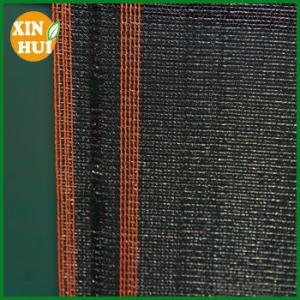Plastic Garden Fence Net
- Loading Port:
- China Main Port
- Payment Terms:
- TT or L/C
- Min Order Qty:
- 2000KG m²
- Supply Capability:
- 500T/MONTH m²/month
OKorder Service Pledge
OKorder Financial Service
You Might Also Like
Introduction of Garden Fence Net :
It is a perfect outdoor fabric. Designed to breathe, it allows cooling breezes to flow through, significantly reducing temperatures beneath. It prevents from tearing and fraying and ensures colors remain vivid for years.
Specifications of Garden Fence Net :
Material base fabric | Fabric Weight | Uv. Content |
HDPE | 180gsm up to 350gsm Standard weight: 100gsm, 110gsm, 120gsm, 140gsm, 160gsm | 0.5% |
Width: 1m, 2m,
Length: 5m, 10m, 50m
Color: Orange, Yellow, Green, or any colorful strips
Applications of Garden Fence Net :
- Keep cool on the beach
- Ideal for areas shared by plants and people
Packing of Garden Fence Net ::in rolls or sheets in transparent plastic film bags with labels inside, and loosely loaded into the container or pallet.

- Q: How do plastic nets help in water filtration?
- Plastic nets help in water filtration by acting as a physical barrier that prevents large debris, such as leaves and twigs, from entering the filtration system. This helps to protect the filtration equipment and ensures that water flows smoothly through the system. Additionally, plastic nets can be used in combination with other filter media, such as sand or activated carbon, to enhance the filtration process by trapping smaller particles and impurities.
- Q: Are plastic nets customizable in terms of size and shape?
- Yes, plastic nets are customizable in terms of size and shape.
- Q: What materials are commonly used to make plastic nets?
- The most commonly used materials to make plastic nets are polyethylene (PE), polypropylene (PP), and nylon.
- Q: What are the different colors available for plastic nets?
- The different colors available for plastic nets vary depending on the manufacturer and purpose. Some common colors include black, white, green, blue, red, and yellow.
- Q: How do plastic nets help in preventing animal entry?
- Plastic nets act as a physical barrier, preventing animals from entering certain areas. The nets are usually installed in places such as gardens, farms, and fishing areas to keep animals like birds, rodents, and fish from accessing these spaces. This helps protect crops, prevent damage to property, and maintain ecological balance by minimizing human-wildlife conflicts.
- Q: Are plastic nets resistant to impact?
- Yes, plastic nets are generally resistant to impact. They are designed to withstand external forces and provide a protective barrier or support for various applications such as packaging, construction, or sports. However, the level of impact resistance can vary depending on the specific type and quality of the plastic net.
- Q: Do plastic nets have any impact on water drainage?
- Yes, plastic nets can have an impact on water drainage. When placed over soil or in drainage systems, plastic nets can obstruct the flow of water, leading to reduced drainage capacity. This can result in water pooling or flooding in certain areas.
- Q: Can plastic nets be used for fishing nets?
- Yes, plastic nets can be used for fishing nets.
- Q: Are plastic nets used in the construction of greenhouses?
- Yes, plastic nets are commonly used in the construction of greenhouses. They are used to provide shade, support climbing plants, and protect crops from pests and harsh weather conditions.
- Q: Can plastic nets be used for anti-bird netting in agricultural fields?
- Yes, plastic nets can be used for anti-bird netting in agricultural fields. These nets are durable, lightweight, and can effectively prevent birds from damaging crops by acting as a physical barrier. They are widely used in agriculture to protect fruits, vegetables, and other crops from bird infestation, reducing the risk of yield loss and increasing crop yield.
1. Manufacturer Overview
| Location | Zhejiang, China |
| Year Established | 1992 |
| Annual Output Value | US$ 10 Million - US$ 50 Million |
| Main Markets | 50% CHINA , 50% OVERSEA |
| Company Certifications | GBT19001-2000 -ISO9001:2000 |
2. Manufacturer Certificates
| a) Certification Name | |
| Range | |
| Reference | |
| Validity Period |
3. Manufacturer Capability
| a) Trade Capacity | |
| Nearest Port | Ningbo ,China |
| Export Percentage | 50% |
| No.of Employees in Trade Department | 6 |
| Language Spoken: | English; Chinese |
| b) Factory Information | |
| Factory Size: | Above 100,000 square meters |
| No. of Production Lines | Above 10 |
| Contract Manufacturing | OEM Service Offered; Design Service Offered |
| Product Price Range | High; Average |
Send your message to us
Plastic Garden Fence Net
- Loading Port:
- China Main Port
- Payment Terms:
- TT or L/C
- Min Order Qty:
- 2000KG m²
- Supply Capability:
- 500T/MONTH m²/month
OKorder Service Pledge
OKorder Financial Service
Similar products
Hot products
Hot Searches
Related keywords

























